Manufacturing process
- 格式:ppt
- 大小:12.62 MB
- 文档页数:8
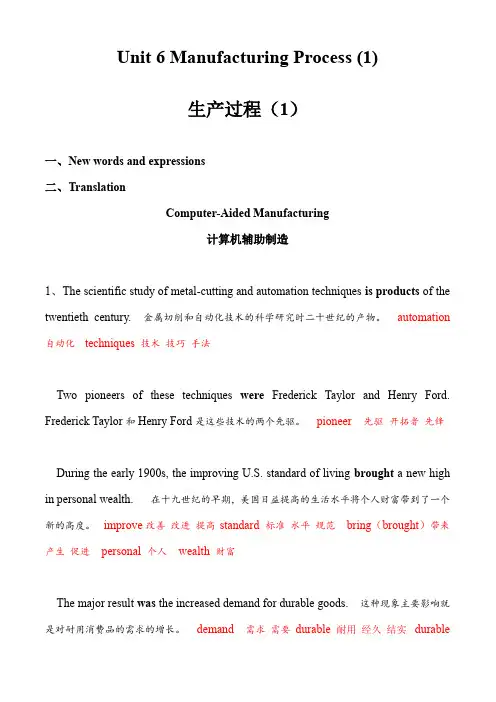
Unit 6 Manufacturing Process (1)生产过程(1)一、New words and expressions二、TranslationComputer-Aided Manufacturing计算机辅助制造1、The scientific study of metal-cutting and automation techniques is products of the twentieth century. 金属切削和自动化技术的科学研究时二十世纪的产物。
automation 自动化techniques 技术技巧手法Two pioneers of these techniques were Frederick Taylor and Henry Ford. Frederick Taylor和Henry Ford是这些技术的两个先驱。
pioneer 先驱开拓者先锋During the early 1900s, the improving U.S. standard of living brought a new high in personal wealth. 在十九世纪的早期,美国日益提高的生活水平将个人财富带到了一个新的高度。
improve改善改进提高standard 标准水平规范bring(brought)带来产生促进personal 个人wealth 财富The major result was the increased demand for durable goods. 这种现象主要影响就是对耐用消费品的需求的增长。
demand 需求需要durable耐用经久结实durablegood 耐用消费品This increased demand meant that manufacturing could not longer be treated as a blacksmith trade, and the use of scientific study was employed in manufacturing analysis. 日益增长的需求意味着制造业不再是简单的手工作坊式的行业,而应该在制造业中引入科学化的研究手段。
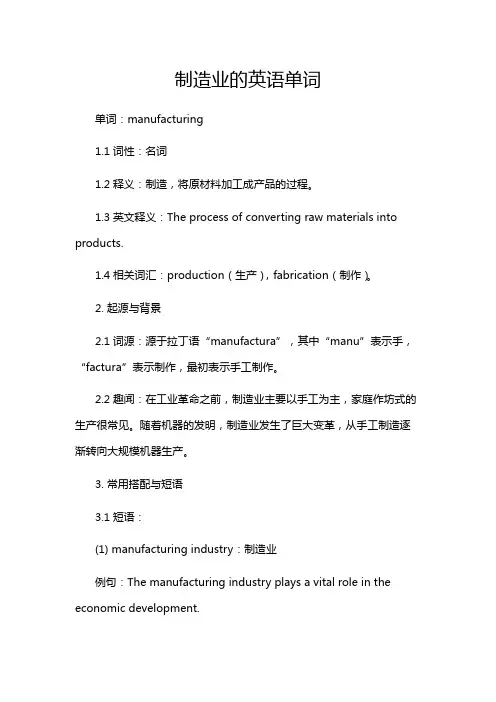
制造业的英语单词单词:manufacturing1.1词性:名词1.2释义:制造,将原材料加工成产品的过程。
1.3英文释义:The process of converting raw materials into products.1.4相关词汇:production(生产),fabrication(制作)。
2. 起源与背景2.1词源:源于拉丁语“manufactura”,其中“manu”表示手,“factura”表示制作,最初表示手工制作。
2.2趣闻:在工业革命之前,制造业主要以手工为主,家庭作坊式的生产很常见。
随着机器的发明,制造业发生了巨大变革,从手工制造逐渐转向大规模机器生产。
3. 常用搭配与短语3.1短语:(1) manufacturing industry:制造业例句:The manufacturing industry plays a vital role in the economic development.翻译:制造业在经济发展中起着至关重要的作用。
(2) manufacturing process:制造过程例句:They are constantly optimizing the manufacturing process to reduce costs.翻译:他们不断优化制造过程以降低成本。
(3) manufacturing plant:制造厂例句:There is a large manufacturing plant in this area.翻译:这个地区有一个大型制造厂。
4. 实用片段(1) "I'm thinking of working in the manufacturing field. I heard there are a lot of job opportunities there." "Yes, but it can be quite challenging as well. You need to be familiar with the manufacturing process."翻译:“我正在考虑进入制造业工作。
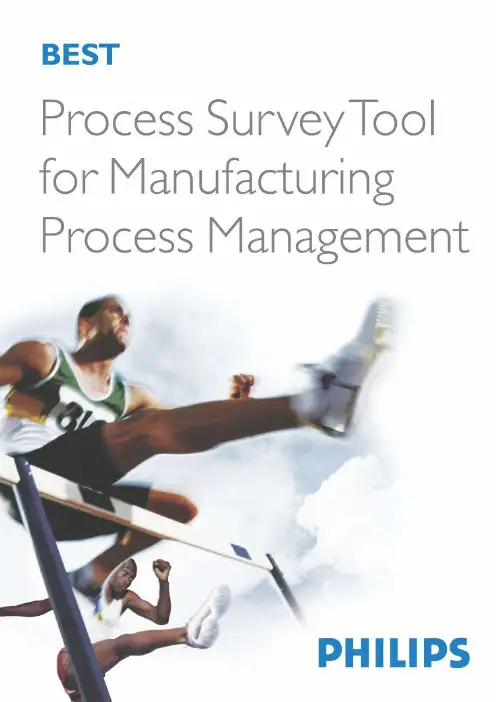
Process Survey Tool for Manufacturing Process Management生产过程管理评估工具Published by : Philips Corporate QualityContent owner : Wim Proper, Philips CFT, Innovation & Industrial Support Version number : 2.0Publication date : October 2003© Koninklijke Philips Electronics N.V. 2003Content overview 目录1Introduction 简介3 2Assessment criteria 审核标准5 3Elements 要素7 4Scope and application 应用范围9 5Clarification of specific terms used 术语使用说明10 Element 1:Control plans 控制计划11 Element 2: Procedures 程序18 Element 3: Quality of supplied materials 原材料22 Element 4: Measurement systems 测量系统26 Element 6: Process capability / process performance 过程能力/过程绩效30 Element 7: Process control 过程控制36 Element 8: Reaction to problems 对问题的反应44 Element 9: Handling and packing 产品处置与包装48 Element 10: Continuous improvement 持续改进52 Element 11: Interface management 接口管理56 Element 12: Breakdown and preventive maintenance 停机与预防性维修保养601Introduction 简介The Philips Quality Policy Board has decided to make available a number of Process Survey Tools to support the Corporate BEST programme. More information concerning the use of these tools is available on the Philips BEST Intranet site (). The Process Survey Tool for ManufacturingProcess Management is one of these tools. A more generic version has replaced the earlier Lighting version 2.2 which was developed by Philips Lighting as an aid to planning improvements in Process Management, identifying the current level of maturity of manufacturing units, and to stimulate the sharing of best practice. The survey tool covers process control and is complimentary to other survey tools, e.g.Manufacturing Maintenance.飞利浦质量政策董事会决定使用一系列有效的过程评估工具作为对BEST(卓越企业)项目的支持。
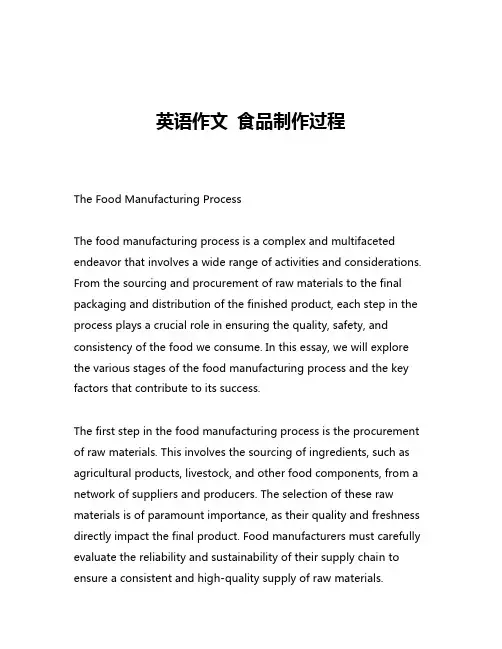
英语作文食品制作过程The Food Manufacturing ProcessThe food manufacturing process is a complex and multifaceted endeavor that involves a wide range of activities and considerations. From the sourcing and procurement of raw materials to the final packaging and distribution of the finished product, each step in the process plays a crucial role in ensuring the quality, safety, and consistency of the food we consume. In this essay, we will explore the various stages of the food manufacturing process and the key factors that contribute to its success.The first step in the food manufacturing process is the procurement of raw materials. This involves the sourcing of ingredients, such as agricultural products, livestock, and other food components, from a network of suppliers and producers. The selection of these raw materials is of paramount importance, as their quality and freshness directly impact the final product. Food manufacturers must carefully evaluate the reliability and sustainability of their supply chain to ensure a consistent and high-quality supply of raw materials.Once the raw materials have been obtained, the next stage in the process is the preparation and processing of these ingredients. This may involve a range of activities, such as cleaning, sorting, cutting, mixing, and cooking, depending on the specific requirements of the product. During this stage, food manufacturers must adhere to strict safety and quality control protocols to ensure the elimination of any potential contaminants or impurities. This may include the implementation of rigorous sanitation procedures, the use of specialized equipment, and the monitoring of critical control points throughout the production process.Following the preparation and processing of the raw materials, the next step in the food manufacturing process is the actual production of the final product. This may involve a variety of techniques, such as baking, frying, canning, or freezing, depending on the nature of the product. During this stage, food manufacturers must carefully control the temperature, humidity, and other environmental factors to ensure the consistent quality and safety of the product.One of the key aspects of the food manufacturing process is the implementation of quality control measures. This involves the continuous monitoring and testing of the product at various stages of the production process to ensure that it meets the required standards for safety, quality, and consistency. This may include theuse of advanced analytical techniques, such as microbiological testing, sensory analysis, and chemical analysis, to detect any potential issues or deviations from the established specifications.In addition to quality control, food manufacturers must also adhere to a range of regulatory and compliance requirements. These may include local, national, and international standards and regulations related to food safety, labeling, and packaging. Food manufacturers must stay up-to-date with these regulations and ensure that their production processes and final products comply with all applicable laws and guidelines.Another important aspect of the food manufacturing process is the packaging and distribution of the final product. Proper packaging is essential for preserving the quality and freshness of the product, as well as for ensuring its safe transportation and storage. Food manufacturers must carefully select the appropriate packaging materials and methods to protect the product from environmental factors, such as light, air, and moisture, and to maintain its shelf life.The distribution of the final product is also a critical component of the food manufacturing process. Food manufacturers must establish efficient logistics and transportation systems to ensure that the product reaches the consumer in a timely and cost-effective manner. This may involve the use of specialized transportation vehicles,temperature-controlled storage facilities, and advanced tracking and monitoring systems to ensure the integrity of the product throughout the supply chain.Finally, the food manufacturing process also involves a significant amount of research and development. Food manufacturers must continuously innovate and adapt to changing consumer preferences, technological advancements, and market trends. This may involve the development of new products, the improvement of existing formulations, and the exploration of alternative ingredients and production methods. By staying at the forefront of these developments, food manufacturers can ensure that they remain competitive and responsive to the ever-evolving needs of the market.In conclusion, the food manufacturing process is a complex and multifaceted endeavor that requires a careful balance of scientific, technological, and managerial expertise. From the sourcing of raw materials to the distribution of the final product, each stage of the process plays a crucial role in ensuring the quality, safety, and consistency of the food we consume. By adhering to strict quality control measures, regulatory requirements, and innovative research and development practices, food manufacturers can continue to provide consumers with safe, nutritious, and enjoyable food products.。
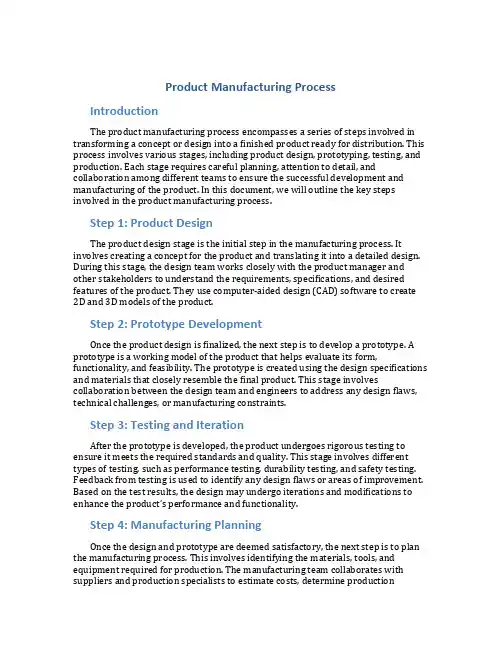
Product Manufacturing ProcessIntroductionThe product manufacturing process encompasses a series of steps involved in transforming a concept or design into a finished product ready for distribution. This process involves various stages, including product design, prototyping, testing, and production. Each stage requires careful planning, attention to detail, and collaboration among different teams to ensure the successful development and manufacturing of the product. In this document, we will outline the key steps involved in the product manufacturing process.Step 1: Product DesignThe product design stage is the initial step in the manufacturing process. It involves creating a concept for the product and translating it into a detailed design. During this stage, the design team works closely with the product manager and other stakeholders to understand the requirements, specifications, and desired features of the product. They use computer-aided design (CAD) software to create 2D and 3D models of the product.Step 2: Prototype DevelopmentOnce the product design is finalized, the next step is to develop a prototype. A prototype is a working model of the product that helps evaluate its form, functionality, and feasibility. The prototype is created using the design specifications and materials that closely resemble the final product. This stage involves collaboration between the design team and engineers to address any design flaws, technical challenges, or manufacturing constraints.Step 3: Testing and IterationAfter the prototype is developed, the product undergoes rigorous testing to ensure it meets the required standards and quality. This stage involves different types of testing, such as performance testing, durability testing, and safety testing. Feedback from testing is used to identify any design flaws or areas of improvement. Based on the test results, the design may undergo iterations and modifications to enhance the product’s performance and functionality.Step 4: Manufacturing PlanningOnce the design and prototype are deemed satisfactory, the next step is to plan the manufacturing process. This involves identifying the materials, tools, and equipment required for production. The manufacturing team collaborates with suppliers and production specialists to estimate costs, determine productionvolume, and set timelines. Additionally, they create a detailed manufacturing plan that outlines the production steps, assembly processes, and quality control measures.Step 5: ProductionDuring the production stage, the product design is translated into a physical product. This stage involves sourcing the raw materials, setting up the production line, and manufacturing the product in bulk quantities. The manufacturing team oversees the assembly, quality control, and packaging processes to ensure consistency and adherence to quality standards. Regular monitoring and inspections are conducted to identify any deviations or defects in the manufacturing process.Step 6: Quality ControlQuality control plays a vital role in ensuring that the manufactured products meet the desired quality standards. This involves implementing quality assurance measures at every stage of the manufacturing process. The quality control team conducts inspections, tests samples, and verifies that the product meets the required specifications. Any deviations or defects are captured, analyzed, and addressed to prevent further issues.Step 7: Packaging and DistributionOnce the products pass the quality control checks, they are packaged and prepared for distribution. Proper packaging ensures the product’s safety during transportation and storage. The packaging design and labeling are carefully considered to attract customers and convey essential information. The products are then distributed to wholesalers, retailers, or directly to end consumers, depending on the distribution strategy.ConclusionThe product manufacturing process is a comprehensive journey that transforms a concept into a tangible product. It involves several key steps, including product design, prototyping, testing, production, quality control, and distribution. Each step requires careful planning, collaboration, and attention to detail to ensure that the final product meets the desired specifications and quality standards. By following this process, businesses can streamline their manufacturing operations and deliver high-quality products to their customers.。
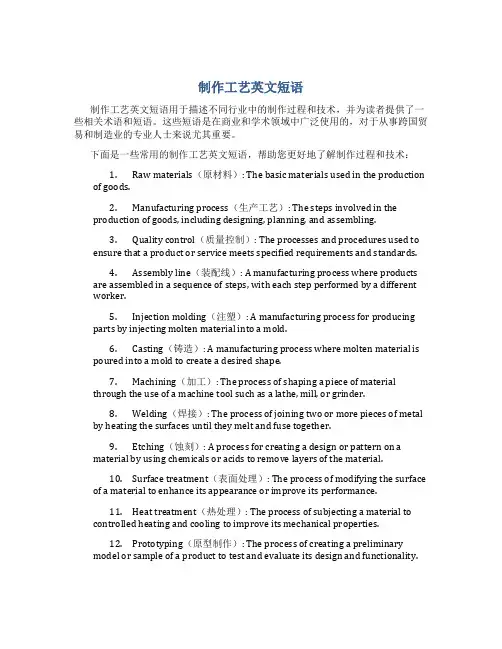
制作工艺英文短语制作工艺英文短语用于描述不同行业中的制作过程和技术,并为读者提供了一些相关术语和短语。
这些短语是在商业和学术领域中广泛使用的,对于从事跨国贸易和制造业的专业人士来说尤其重要。
下面是一些常用的制作工艺英文短语,帮助您更好地了解制作过程和技术:1.Raw materials(原材料): The basic materials used in the productionof goods.2.Manufacturing process(生产工艺): The steps involved in theproduction of goods, including designing, planning, and assembling.3.Quality control(质量控制): The processes and procedures used toensure that a product or service meets specified requirements and standards.4.Assembly line(装配线): A manufacturing process where productsare assembled in a sequence of steps, with each step performed by a different worker.5.Injection molding(注塑): A manufacturing process for producingparts by injecting molten material into a mold.6.Casting(铸造): A manufacturing process where molten material ispoured into a mold to create a desired shape.7.Machining(加工): The process of shaping a piece of materialthrough the use of a machine tool such as a lathe, mill, or grinder.8.Welding(焊接): The process of joining two or more pieces of metalby heating the surfaces until they melt and fuse together.9.Etching(蚀刻): A process for creating a design or pattern on amaterial by using chemicals or acids to remove layers of the material.10.Surface treatment(表面处理): The process of modifying the surfaceof a material to enhance its appearance or improve its performance.11.Heat treatment(热处理): The process of subjecting a material tocontrolled heating and cooling to improve its mechanical properties.12.Prototyping(原型制作): The process of creating a preliminarymodel or sample of a product to test and evaluate its design and functionality.13.Quality assurance(质量保证): The activities and processes used toensure that a product or service meets specified requirements and customerexpectations.14.Lean manufacturing(精益制造): A production philosophy andmethodology that focuses on minimizing waste and maximizing value for thecustomer.15.Continuous improvement(持续改进): The ongoing effort toimprove products, services, and processes through incremental and innovative changes.以上是一些常见的制作工艺英文短语,涵盖了不同行业的制作过程和技术。
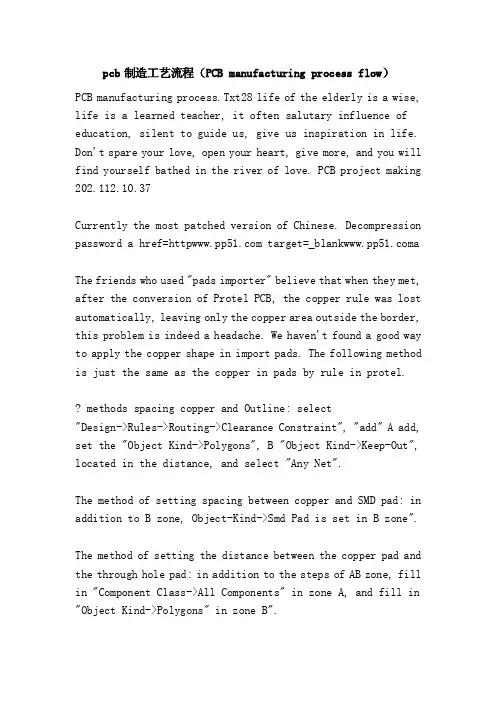
pcb制造工艺流程(PCB manufacturing process flow)PCB manufacturing process.Txt28 life of the elderly is a wise, life is a learned teacher, it often salutary influence of education, silent to guide us, give us inspiration in life. Don't spare your love, open your heart, give more, and you will find yourself bathed in the river of love. PCB project making 202.112.10.37Currently the most patched version of Chinese. Decompression password a href= target=_aThe friends who used "pads importer" believe that when they met, after the conversion of Protel PCB, the copper rule was lost automatically, leaving only the copper area outside the border, this problem is indeed a headache. We haven't found a good way to apply the copper shape in import pads. The following method is just the same as the copper in pads by rule in protel.methods spacing copper and Outline: select"Design->Rules->Routing->Clearance Constraint", "add" A add, set the "Object Kind->Polygons", B "Object Kind->Keep-Out", located in the distance, and select "Any Net".The method of setting spacing between copper and SMD pad: in addition to B zone, Object-Kind->Smd Pad is set in B zone".The method of setting the distance between the copper pad and the through hole pad: in addition to the steps of AB zone, fill in "Component Class->All Components" in zone A, and fill in "Object Kind->Polygons" in zone B".After the Rules is set up, it will be checked by DRC, and the speed is relatively slow. It can be pressed directly by ESC. Finally, in the copper area double-click, select the corresponding layer, such as "Polygon on Top", click the OK button will prompt Rebuild, determine that you can.First, PCB manufacturing process flow:A >, back of a film version.Back of a film version is printed circuit board production process leading, quality directly affects the back of a film version of the printed circuit board production. In the production of a printed circuit board, there must be at least a corresponding back of a film version. Each conductive pattern (signal layer, circuit diagram, ground and power layer pattern) and non conductive pattern (solder resist figure and character) should have at least one film negative. Through the photochemical transfer process, a variety of graphics transferred to the production plate.In the back of a film printed board production version are in use:Pattern of photosensitive mask in pattern transfer, including line pattern and photo resist welding pattern.Screen printing process, including solder resist graphics and characters.NC programming and drilling reference for machining (drillingand contour milling) NC machine tools.With the development of electronic industry, the requirement of PCB is higher and higher. Printed circuit board design of high density, thin wire, small aperture tends to be faster and faster, the production process of printed circuit board is also more and more perfect. In this case, if there is no high quality version can produce the back of a film, printed circuit board with high quality. Modern PCB production requirements need to meet the following conditions of back of a film version:The size precision must be consistent with the back of a film version of precision PCB requirements, and should take into account the deviation caused by the production process of compensation.Back of a film version of the graphics should meet the design requirements, complete graphical symbols.Straight back of a film version of the image edge is neat, the edge is not trivial; black and white contrast, meet photosensitive process requirements.Back of a film version of the material has good dimensional stability, which is caused by the environment temperature and humidity of the small size change.Double sided and multilayer back of a film version, require coincident accuracy pads and good public figure.Back of a film version of each layer shall be clearly markedor named.Through the back of a film banpian wavelength is required, the general needs of the sensitive wavelength range of 3000--4000A.Before making the back of a film version, usually need to first produce photographic map, making the back of a film version of the complete version of the camera or. This year,With the rapid development of computer technology, production version of the back of a film has a great development. The use of advanced laser drawing technology, which greatly improves the quality of production speed and bottom slab, and can produce high precision, fine line graph the past cannot be completed, the PCB production CAM technology tends to be perfect.Two > substrate materials.Copper clad laminate (Copper Clad Laminates, abbreviated as CCL), referred to as copper clad laminate or copper clad laminate (PCB), is the substrate material for manufacturing printed circuit boards (hereinafter referred to as PCB). PCB, the most widely used etching method, is a selective etching of copper clad laminates to obtain the desired circuitry. Copper clad laminate (PCB) is mainly responsible for three functions of conducting, insulating and supporting in the whole printed circuit board. The performance, quality and manufacturing cost of printed circuit boards largely depend on the copper clad laminate.Three > basic manufacturing process.Printed circuit boards can be divided into single-sided, double-sided and multilayer printed boards according to the number of layers of the conductor pattern. The basic manufacturing process of the single panel is as follows:Clad plate blanking plate drying -- > -- > (to prevent deformation) -- > mold wash, dry film -- > -- > (or screen printing), exposure and development (or corrosion ink) to film his electrical etching -- > -- > -- > -- > on-off detecting cleaning screen printing solder (green printing graphics) -- > -- > curing printing tag number -- > -- > -- > -- > shape processing of curing borehole cleaning and drying test of packaging products -- > -- > -- >.The basic manufacturing process of the double sided panel is as follows:In recent years, the typical processes for manufacturing double-sided printed circuit boards (PCB) are SMOBC method and graphic electroplating method. In some special occasions, the process traverse method is also used.1. graphic electroplating process.Clad plate blanking punching / drilling / NC drilling test datum hole -- > -- > -- > > to? Chemical plating thin copper plating thin copper -- > -- > -- > -- > test brush plate (or film printing) -- > exposure developing (or curing) / test trimming (Cn ten ball pattern plating Sn / Pb / go) film etching test repair plate -- > -- > -- > -- > -- > plug gold plating cleaning electricalon-off detecting hot melt cleaning / screen printing / solder curing printing graphic notation -- > -- > -- > -- > -- > curing shape processing of cleaning and drying test of packaging products -- > -- > -- >."In the process of electroless plating of copper thin thin copper /" available "the two processes of electroless thick copper plating" a process of substitution, both have advantages and disadvantages. Pattern electroplating -- etching method of double hole metallization plate is a typical process in six and 70s. In 80s, the bare copper cladding welding process (SMOBC) gradually developed, especially in precision double panel manufacturing has become the mainstream technology.2. bare copper solder mask (SMOBC) processThe main advantages of the SMOBC board is to solve the solder bridging short-circuit phenomenon between fine lines, at the same time as the SN ratio constant, weldability and storage have better heat melting plate.A manufacturing method of SMOBC board, SMOBC technology standard pattern plating subtracting back of tin with tin or tin dipping; instead of subtracting graphic process of electroplating SMOBC tin lead plating; plugging holes or blind hole method SMOBC process; plus SMOBC process. The following SMOBC process introduces the graphics plating back of tin and hole plugging method SMOBC process.SMOBC process and return of tin plating method is similar to the graphic pattern plating process. Change only after etching.Double sided copper clad plate by electroplating method to process graphics -- > -- > -- > check back etching tin ball cleaningI Solder plug gold plating plug graphics -- > -- > -- > tape hot air leveling cleaning ballHis printing marks his shape processing his dry cleaning his final inspection of finished packaging -- > -- >.The main technological process of plugging hole is as follows:Double clad plate / drilling panel plating electroless copper plating -- > -- > -- > -- > copper hole blocking screen printing imaging (as)To screen printing material -- > -- > etching, hole blocking material / cleaning solder plug graphics -- > -- > nickel, gold plated-- > plug tape -- > HASL -- > below and the same to the finished product.The process is simple, and the key is the plugging and cleaning of the ink hole.In the plugging process, if the hole is not blocked by ink and screen printing, and a special masking type dry film is used to cover the hole, and then the exposure is made as a positive figure, which is the masking process. Compared with the holeplugging method, there is no longer the problem of ink in the cleaning hole, but it has a higher requirement for masking the dry film.The basis of SMOBC process is to produce bare copper hole metal double plate, and then apply hot air leveling technology.Two, PCB engineering production:For the production of PCB printed circuit board, because many designers do not understand the production process of circuit board, the circuit diagram is only the most basic circuit diagram, and can not be directly used for production. Therefore, in the actual production need to revise and edit files on the line, not only need to produce can be suitable for the production process of the plant Feilintu, but need to make drilling data, the corresponding model data, as well as to produce other useful data. It is directly related to the future of the production engineering. All these require engineers to understand the production process necessary, and master the relevant software, including the circuit design of common software such as: Protel, Pads2000, Autocad and so on, should be more familiar with the necessary CAM software such as: View2001, CAM350; GCCAM, CAM should include PCB design input, the circuit may be graphics editing, correction, repair and up to disk as the medium material, automation data and output light draw, drilling and testing.The basic requirements of PCB engineering.The level of PCB engineering design can reflect the design levelof the designer, and also can reflect the production process ability and technical level of the printed circuit board manufacturer. At the same time as the PCB project production into computer aided design and computer aided manufacture in one, precision and accuracy is very high, otherwise it will affect the electrical performance of final board electronic products, may cause serious error, which led to the whole batch of printed circuit board scrap and delay manufacturers contract delivery time, and suffered economic losses. Therefore, as a PCB engineering producer, we must always bear in mind the importance of their own responsibility, must not be taken lightly, must be careful, serious, careful and serious. When handling PCB design documents, they should be carefully checked:Does the receiving document conform to the rules set by the designer? Can it meet the requirements of PCB manufacturing process? Are there any positioning markers?Is the route layout reasonable? Whether the distance between wire and wire, wire and component pad, wire and through hole, component pad and through hole, through hole and through hole is reasonable, can meet the production requirements. Does the element conflict in 2D and 3D space?Is the PCB size consistent with the processing drawings? Does the pattern (such as icons, labels) added to the PCB graph cause a signal to be shorted?.Edit and modify some undesirable alignment.Is there a process line on the PCB? Whether the welding resistance meets the requirements of the production process, whether the welding size is appropriate, whether the character mark is pressed on the device pad, so as not to affect the quality of denso. Etc....Two > drawing data generation.1, make up.PCB design is completed because the PCB shape is too small, can not meet the requirements of the production process, or a product by a few pieces of PCB, so you need to put up a small number of areas meet the production requirements of the large plate, or more than one PCB for a product together and facilitate the production of electrical equipment. The former is similar to the stamp board, it can not only meet the technological conditions for production of PCB components for Denso, separately, then in use is very convenient; the latter is a product of several sets of PCB plates are assembled together, so it is convenient for production, a full set of products, clear.。
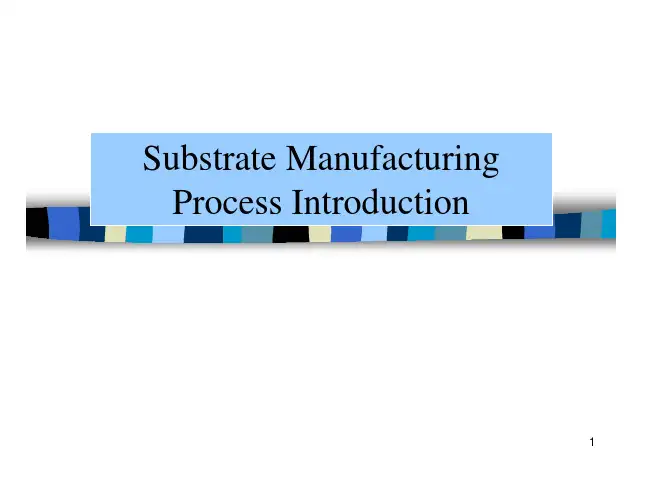
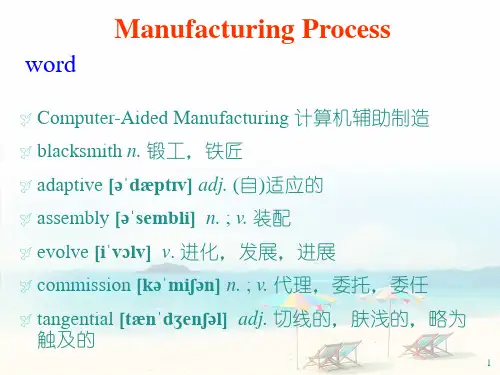
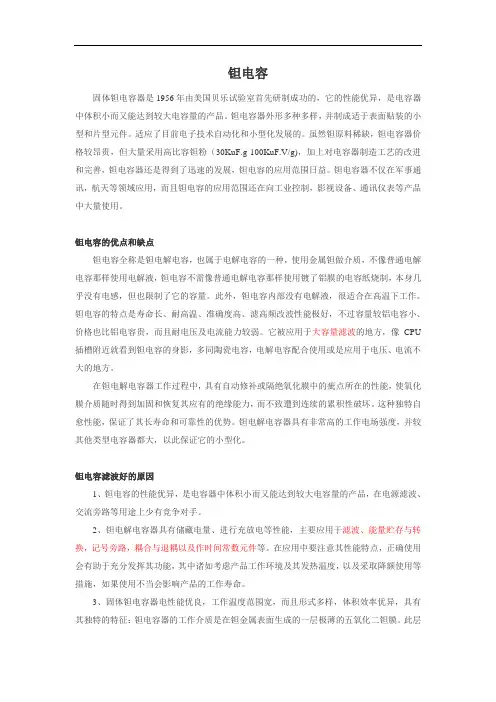
钽电容固体钽电容器是1956年由美国贝乐试验室首先研制成功的,它的性能优异,是电容器中体积小而又能达到较大电容量的产品。
钽电容器外形多种多样,并制成适于表面贴装的小型和片型元件。
适应了目前电子技术自动化和小型化发展的。
虽然钽原料稀缺,钽电容器价格较昂贵,但大量采用高比容钽粉(30KuF.g-100KuF.V/g),加上对电容器制造工艺的改进和完善,钽电容器还是得到了迅速的发展,钽电容的应用范围日益。
钽电容器不仅在军事通讯,航天等领域应用,而且钽电容的应用范围还在向工业控制,影视设备、通讯仪表等产品中大量使用。
钽电容的优点和缺点钽电容全称是钽电解电容,也属于电解电容的一种,使用金属钽做介质,不像普通电解电容那样使用电解液,钽电容不需像普通电解电容那样使用镀了铝膜的电容纸烧制,本身几乎没有电感,但也限制了它的容量。
此外,钽电容内部没有电解液,很适合在高温下工作。
钽电容的特点是寿命长、耐高温、准确度高、滤高频改波性能极好,不过容量较铝电容小、价格也比铝电容贵,而且耐电压及电流能力较弱。
它被应用于大容量滤波的地方,像CPU 插槽附近就看到钽电容的身影,多同陶瓷电容,电解电容配合使用或是应用于电压、电流不大的地方。
在钽电解电容器工作过程中,具有自动修补或隔绝氧化膜中的疵点所在的性能,使氧化膜介质随时得到加固和恢复其应有的绝缘能力,而不致遭到连续的累积性破坏。
这种独特自愈性能,保证了其长寿命和可靠性的优势。
钽电解电容器具有非常高的工作电场强度,并较其他类型电容器都大,以此保证它的小型化。
钽电容滤波好的原因1、钽电容的性能优异,是电容器中体积小而又能达到较大电容量的产品,在电源滤波、交流旁路等用途上少有竞争对手。
2、钽电解电容器具有储藏电量、进行充放电等性能,主要应用于滤波、能量贮存与转换,记号旁路,耦合与退耦以及作时间常数元件等。
在应用中要注意其性能特点,正确使用会有助于充分发挥其功能,其中诸如考虑产品工作环境及其发热温度,以及采取降额使用等措施,如果使用不当会影响产品的工作寿命。
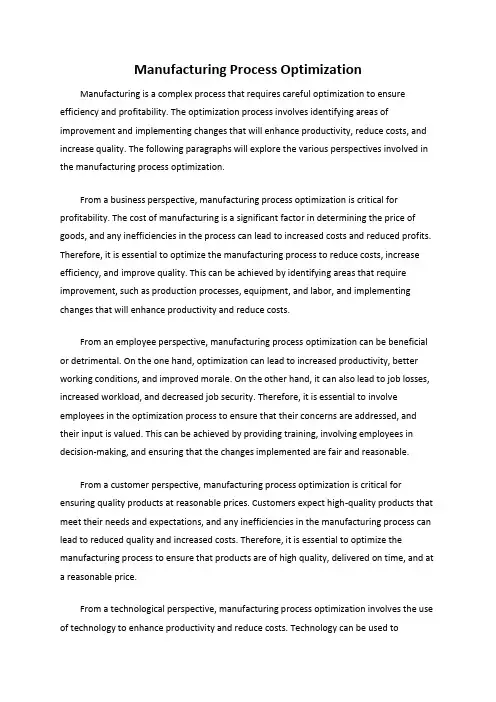
Manufacturing Process OptimizationManufacturing is a complex process that requires careful optimization to ensure efficiency and profitability. The optimization process involves identifying areas of improvement and implementing changes that will enhance productivity, reduce costs, and increase quality. The following paragraphs will explore the various perspectives involved in the manufacturing process optimization.From a business perspective, manufacturing process optimization is critical for profitability. The cost of manufacturing is a significant factor in determining the price of goods, and any inefficiencies in the process can lead to increased costs and reduced profits. Therefore, it is essential to optimize the manufacturing process to reduce costs, increase efficiency, and improve quality. This can be achieved by identifying areas that require improvement, such as production processes, equipment, and labor, and implementing changes that will enhance productivity and reduce costs.From an employee perspective, manufacturing process optimization can be beneficial or detrimental. On the one hand, optimization can lead to increased productivity, better working conditions, and improved morale. On the other hand, it can also lead to job losses, increased workload, and decreased job security. Therefore, it is essential to involve employees in the optimization process to ensure that their concerns are addressed, and their input is valued. This can be achieved by providing training, involving employees in decision-making, and ensuring that the changes implemented are fair and reasonable.From a customer perspective, manufacturing process optimization is critical for ensuring quality products at reasonable prices. Customers expect high-quality products that meet their needs and expectations, and any inefficiencies in the manufacturing process can lead to reduced quality and increased costs. Therefore, it is essential to optimize the manufacturing process to ensure that products are of high quality, delivered on time, and at a reasonable price.From a technological perspective, manufacturing process optimization involves the use of technology to enhance productivity and reduce costs. Technology can be used toautomate processes, monitor production, and improve quality control. For example, the use of robotics in manufacturing can lead to increased productivity, reduced labor costs, and improved quality control. Therefore, it is essential to invest in technology to optimize the manufacturing process continually.From a regulatory perspective, manufacturing process optimization involves complying with regulations and standards that govern the manufacturing process. Regulations and standards are in place to ensure that products are safe, of high quality, and meet the needs of consumers. Therefore, it is essential to comply with regulations and standards to ensure that products are safe and of high quality.In conclusion, manufacturing process optimization is critical for ensuring efficiency, profitability, and customer satisfaction. It involves identifying areas of improvement, implementing changes, involving employees, investing in technology, and complying with regulations and standards. Therefore, it is essential to approach the optimization process from multiple perspectives to ensure that all stakeholders are considered, and their concerns are addressed.。
4‐1 Lecture 4 Manufacturing Process(製造流程)• 4.1 Production Processes (生產流程)• 4.2 How manufacturing processes are organized• 4.3 Manufacturing process flow design (設計)• 4.4 Manufacturing layout (佈置)•性能指標:彈性、價格或成本、4-1 Production Processes (生產流程)•Lead time (前置時間): The time needed to respond to a customer order (訂單)•Customer order decoupling point (訂單分界點): where inventory is positioned in the supply chain to operate independently (獨立)4‐2Make-to-Stock (存貨生產)•Serve customers from finished goods (成品) inventory –Televisions, clothing, packaged food products •Balance: The level of inventory and customer service –Easy with unlimited (無限) inventory, but inventorycosts money•Use lean (精實) manufacturing to achieve higher service levels for a given inventory investment. (in LectureAssemble-to-Order (接單裝配)•Combine a number of preassembled modules (預先組成的模組) to meet a customer’s specifications (•Define a customer’s order in terms of alternative (供選擇的) components because these are carried in inventory–Dell Computer : 5 處理器⨯4 硬碟⨯6 螢幕= 120 種–Significant advantages: The customer order decoupling point from finished goods (120) to components (15).•One capability required is a design that enables as much flexibility (彈性) as possible in combining components.Make-to-Order/Engineer-to-Order •Make-to-Order (接單生產): Makethe customer’s product from rawmaterials, parts, and components–Boeing’s process for makingcommercial aircraft (飛機)•Engineer-to-Order (接單設計):Work with the customer to designand then make the product•Customer order decoupling pointcould be in either raw materials atthe manufacturing site or thesupplier inventory.4‐6 4-2 How manufacturing processesare organized (組織) (1)•Project Layout (專案佈置): The product remains in a fixed location–Manufacturing equipment is moved to the product.–例如蓋建築物、電影製•Workcenter(工作中心) (or job shop (零工式)): Similar equipment or functions are grouped together–Sometimes is referred to as a department and isfocused on a particular type of operation. 例如小量生產的玩具:進出貨、塑膠壓模、上色等4‐7 How manufacturing processesare organized (組織) (2)•Manufacturing cell (製造單元): A dedicated (特定) area where products that are similar(相同) in processing requirements are produced–例如金屬製造、電腦晶•Assembly line (裝配線): Work processes are arranged according to the progressive (累進的) steps by which the product is made 例如汽車•Continuous process (連續流程): Assembly line only the flow is continuous such as with liquids–例如煉油、飲料工廠Product–Process Matrix (產品─流程矩陣): Framework Describing Layout StrategiesBreak-Even Analysis (損益平衡分析)• A standard approach to choosing among alternative (不同的) processes or equipment (設備)•Example: Option (選擇) for obtaining a machine part –(1) Purchase (Buy) (購買) for $200, no fixed costs(固定成本)): Total Cost = $200 ⨯Demand–(2) Make the part on a lathe (車床) at $75 per unitwith fixed cost $80,000: Total Cost= Fixed (固定) cost + Variable (變動) cost * demand= $80,000 + $75 ⨯•(3) Make the part on a machining center (綜合加工機) at $15 per unit with fixed cost $200,000: Total Cost =$200,000 + $15 ⨯demandOptimal (最佳) Production•需求[0 B] 則買•需求[B A] 則車床生產(Next slide B = 640, A = •需求>A 則綜合加工機生產Break-even points (損益平衡點)4‐11•A:•B:•Profit (利潤) = Revenue (收入) -Cost (成本)—Assuming the part sells for $300 each—1000 units, maximum (最大) profit = point C -pointD (produced by lathe (車床)) (minimal (最小) cost)4‐12 4-3 Manufacturing Process FlowDesign•係指評估工廠內移動原物料、零件或組件等特定製程之方法•看課本中的圖:裝配圖(Assembly drawing),組裝程序圖(Assembly chart),路線表(Operation and route sheet),流程圖(Process flowchart)•Focus should be on the identification of activities (活動) that can be minimized or eliminated (消防)–Movement and storage–The fewer the moves, delays, and storage, thebetter the flow (SectionExample: Manufacturing ProcessAnalysis•Mold (鑄造) parts (MP), Purchase (買) parts from vendors (PP), Final assembly (FA) (圖下頁)•MP:–10 machines, produce 25 parts per hour per machine–Currently 6 workers. 4 more available•FA–15 workers (8-hr shift) move rate: 150 元件/ hr.–Could hire 15 more workers for a 2nd shift•See the book for cost structureMold (鑄造) partsPurchase partsfrom vendors Final assemblyMolded parts inventoryPurchase partsinventory FinishedgoodsExample Manufacturing Process Analysis:Process Analysis (2)•(d) 單位成本= Total Cost / Total output= (Variable cost * Output + Fixed cost ) / Output= Variable cost + Fixed cost / Output–固定成本:廠房租金,管理,設備折舊–變動成本:原物料,電費,勞動力,購買外部零件–(1) capacity 6,000 / week•Total cost = $6,670 (in the textbook)•Cost / unit = $6,670 / 6,000 =–(2) capacity 10,000 / week•Total cost = $10,350 (in the textbook)•Cost / unit = $10,350 / 10,000 =•量產以達到經濟規模:量大 固定成本除以輸出變小4.4 Facility Layout (設施佈置)•工業管理(或工業工程) 系一學期的課程•The process of determining placement of departments, workgroups within departments, workstations, machines, and stock-holding points within a facility •This process requires the following inputs:1.Specification (準則) of the objectives used to evaluate thedesign2.Estimates of product or service demand3.Processing requirements (需求)4.Space requirements for the elements5.Space availability within the facilityExample: Toy Factory•Goal is to arrange eight workcenters to minimize interdepartmental (各部門間的) handling cost.•Assume all workcenters(工作中心) have same space and fit in building.•All material is transported in standard crates (條板箱) by forklift (鏟車).•Transportation (運輸) costs are $1 to move between adjacent (毗連的) workcenters. Diagonal (對角) moves are permitted so that workcenters2 and 3 are considered adjacent (相鄰的)–Extra $1 for each workcenter in betweenInterworkcenter Flow, and Building Dimensions and Workcenters 4‐19InterworkcenterFlow GraphCost Matrix –First Solution (解)•Route 1 to 2: 175 ⨯1•Route 1 to 5: 30 ⨯•Route 1 to 6: 200 ⨯2 = 400 (對角移動)4‐20Second Solution by Intuition (直覺)•Original cost: 3474•Look at workcenter 1–工作站4 和6 對調,成本•工作站6 和7 距離加倍•8! (= 40,320) possible arrangements!4‐214‐22 Assembly-Line Balancing(裝配線平衡)•將所有任務指派至一系列的工作站,讓每一個工作站的作業時間不超過工作站的週期時間,使得所有工作站之閒置時間最少•Assign tasks to workstations such that the workstations have approximately (接近的) equal time requirements (需求).•某公司使用輸送帶進行裝配作業,每天需生產500 輛休旅車。
1.0 Purpose目的To make sure that production processes of all products are in effective control so that a stable quality could be guaranteed, and customer requirements could be met.目的为确保公司所有产品的生产过程能够在有效的管理状态下进行,保证质量稳定,满足客户要求。
2.0 Scope范围Production of all Components made in our plant.本公司所有产品的生产过程。
3.0 Definitions定义Production delivery date: it refers to the delivery date marked in by Logistics. All the planned processes must be satisfactorily completed before the date, including the final products inspection and packaging.生产交货期:是指物流部确认的交货期,在此之前必须完成所有的生产过程,包括最终检验及包装。
4.0 Procedure and Flow chart 程序及流程图4.1 Responsibility and authority职责与权限4.1.1 AQP dept. is responsible for making the work instructions.项目部负责作业指导书制定。
4.1.2 Process engineer and quality engineer are responsible for making the inspection instructionof production working procedure, and also responsible for planning reference points ofdifferent working procedure.工艺工程师与质量工程师负责制订生产过程工序检验指导书和过程检验标准,并负责策划各工序控制点以及生产工艺流程。
With increasing pressure to bring innovative,lower-cost products to market faster,manufacturers are redoubling efforts to implement concurrent engineering,manufacturing and production processes.Well before products are completely designed,much of the production process can be described,laid out and validated.Executed in a digital environment,this cadence significantly improves productivity and allows multiple product programs to be managed under a single source of information in full association with manufacturing planning and production requirements.By enabling your engineering and manufacturing teams to share a single source of knowledge,tradeoff decisions,investment decisions and resource allocation decisions impacting both domains can be made with crucial visibility into existing assets.Value of manufacturing process management Today’s manufacturers face increasingly shortened development schedules.They need to get as much out of their existing resources as possible.Searching for information,creating production plans from scratch and handling constant change causes productivity to suffer.Teamcenter’smanufacturing process management capabilities provide a consistent source of up-to-dateinformation that increases individual productivity while facilitating process and workflow-controlsolutions.In turn,these solutions boost application and cross-domain productivity by providing openintegrations to existing IT landscapes.Without these capabilities,today’s companies risk:•Delayed market delivery•Unanticipated costs•Lost revenue opportunities•Sub-optimized productionManufacturing process managementRationalize and leverage engineering assets while synchronizing and optimizing manufacturing deliverables BenefitsLeverage engineering assetsMake better,quicker trade-offdecisionsIncrease velocity to full productionReduce project and operations costIdentify issues before they becomecritical problemsCentralize and automate changeprocessesIncrease visibility into globaloperationsCapture and standardize bestpractices across the enterpriseLeverage capacity more efficientlyRespond to market demands withgreater confidenceIncrease profitability by identifyingmore opportunities to re-usemanufacturing assetsReduce the cost and risk ofnon-compliance SummaryTeamcenter®software’s capabilities for manufacturing process management enable customers to collaboratively create,validate and optimize manufacturing plans in full alignment with program requirements.By providing a common environment for multiple disciplines that share the same requirements,Teamcenter drastically improves lifecycle productivity between engineering,manufacturing and production.This reduces waste and increases decision value as information interrelationships are leveraged by a broader audience to arrive at better decisions in a shorter amount of time.Teamcenterfact sheetSiemens PLM Software /teamcenterContactSiemens PLM Software–/teamcenterAmericas8004985351Europe44(0)1276702000Asia-Pacific852********©2010Siemens Product Lifecycle Management Software Inc.All rights reserved.Siemens and the Siemens logo are registered trademarks of Siemens AG.D-Cubed,Femap,Geolus,GO PLM,I-deas,Insight,Jack,JT,NX,Parasolid,Solid Edge,Teamcenter,Tecnomatix and Velocity Series are trademarks or registered trademarks of Siemens Product Lifecycle Management Software Inc.or its subsidiaries in the United States and in other countries.All other logos,trademarks,registered trademarks or service marks used herein are the property of their respective holders.W14117532/10B。
专利名称:manufacturing process of 发明人:GUI MARUTENSU,MARUSERU GOTSUDOFUROIDO申请号:JP2724275申请日:19750307公开号:JPS601288B2公开日:19850114专利内容由知识产权出版社提供摘要:1458338 Preparation of 1,1,2-trichloroethane SOLVAY & CIE 7 March 1975 [8 March 1974] 9602/75 Heading C2C 1,1,2-Trichloroethane is obtained by reacting liquid 1,2-dichloroethane with chlorine under boiling conditions in one or more consecutive reactors, each having a peroxide supply and a chlorine inlet, in the presence of one or more of the following peroxides: propionyl, isobutyryl, capriloyl, 3,5,5-trimethyl hexanoyl, decanoyl, lauroyl and 2,4-dichlorobenzoyl peroxides, isopropyl and cyclohexyl percarbonates, and t-butyl perpivalate. The reaction is suitably conducted at a temperature of 80-110‹ C. at pressures which are close to atmospheric pressure. From 10-4 to 2 Î 10-2 mol of peroxide per litre of reaction mixture may be introduced into the, or each, reactor, and the molar ratio of total chlorine to 1,2- dichloroethane is preferably from 0À1 to 1 : 1 to 1À1 : 1. The reaction is preferably carried out in the presence of less than 10-3 mol of oxygen per mol of chlorine and less than 15 parts of ferric ions per million parts of 1,2- dichloroethane. The dwell time of the reactants in the (or each) reactor is generally from 1 to 60 minutes at 80‹ C., 0À25 to 40 minutes at 110‹ C., or certain defined values within these two limits. The process may be carried out either batchwise or continuously, suitable flow diagrams being described.申请人:SOLVAY更多信息请下载全文后查看。
专利名称:MANUFACTURING PROCESS ANDEQUIPMENT FOR MANUFACTURING OFCOATED FURNITURE ELEMENTS ANDCOATED FURNITURE ELEMENTS发明人:DA DALT, FERRUCCIO申请号:IB2007002198申请日:20070724公开号:WO2008012674A3公开日:20081106专利内容由知识产权出版社提供摘要:Manufacturing equipment (5) and process of furniture elements (9) adapted to apply to the same surface covering envelopes, comprising a conventional press (6). Process comprising a first step in which the furniture elements (9) are introduced into said press (6) displaced in the open position, and are arranged, together with the relative templates (18), on to a support plane (15) while the covering envelopes (19) are arranged on to the furniture elements- (9); a second step in which said press (6) is closed and the covering envelopes (19) are placed into thermal contact with a heating plane (25); a third step in which a vacuum pump is activated to contract covering envelopes (19) to the outline of all the furniture elements (9), a fourth step in which said press (6) is open, the coated furniture elements (9) are unloaded from the press, and the furniture elements (9) are detached from the relative templates (18).申请人:WALNUT S.R.L.,DA DALT, FERRUCCIO更多信息请下载全文后查看。
药品工艺流程英文Drug manufacturing processThe drug manufacturing process involves a series of steps that ensure the production of safe and effective medicines. This process includes various stages, from raw material sourcing to final product packaging. In this article, we will outline a general drug manufacturing process for solid dosage forms.1. Raw material sourcing: The first step in the drug manufacturing process is sourcing high-quality raw materials. Active pharmaceutical ingredients (APIs) are the key components of the drug, and they must meet strict quality standards. Excipients, such as binders, fillers, and disintegrants, are also sourced during this stage.2. Pre-formulation: Pre-formulation is the stage where the drug formulation is optimized. It involves testing the physical and chemical properties of the API and excipients to determine which combination is most suitable for the desired dosage form. This stage also includes compatibility studies to ensure that the ingredients do not interact adversely.3. Formulation development: Based on the pre-formulation data, the drug formulation is developed. This involves determining the appropriate quantities of APIs and excipients, as well as the method of mixing. The goal is to create a stable and bioavailable drug product.4. Granulation: Granulation is the process of converting the drugformulation into granules. This is done to improve the flow and compressibility of the powder mixture. Granulation can be achieved through wet or dry methods, depending on the characteristics of the formulation.5. Compression: After granulation, the granules are compressed into tablets using a tablet press machine. The tablets must meet specific weight, hardness, and friability requirements. This stage also includes tablet coating if necessary.6. Packaging: The final product is packaged in appropriate containers, such as blisters, bottles, or sachets. The packaging material must be of high quality to ensure the stability and integrity of the drug.7. Quality control: Throughout the entire drug manufacturing process, quality control is paramount. Various tests and analyses are conducted to ensure the identity, purity, potency, and safety of the drug. This includes testing the raw materials, in-process samples, and final product. Additionally, stability studies are performed to determine the drug's shelf life.8. Regulatory compliance: Drug manufacturers must comply with regulatory requirements and guidelines set by authorities, such as the Food and Drug Administration (FDA) or the European Medicines Agency (EMA). This involves rigorous documentation of all manufacturing and testing activities, as well as adherence to good manufacturing practices (GMP).9. Batch release: Once the drug has undergone all necessary testsand has been deemed compliant with regulatory standards, it is released for distribution. The batch release process ensures that each batch of the drug meets the approved specifications and is safe for consumption.In conclusion, the drug manufacturing process is a complex and highly regulated series of steps. From raw material sourcing to final product packaging, every stage is carefully executed to ensure the production of safe and effective medicines. Quality control and regulatory compliance are integral parts of the process, guaranteeing that each batch of the drug meets the required standards.。